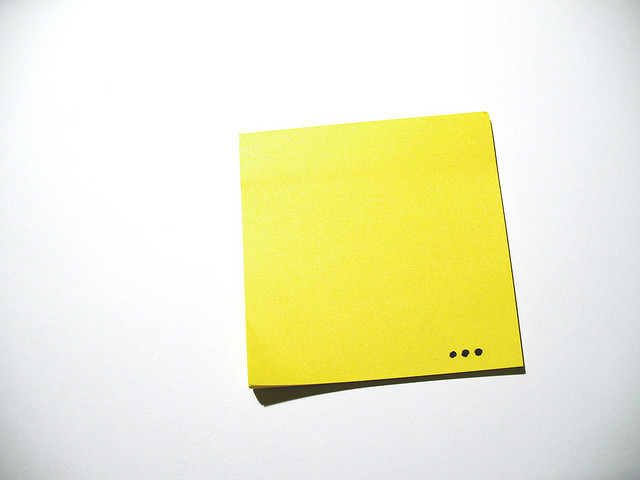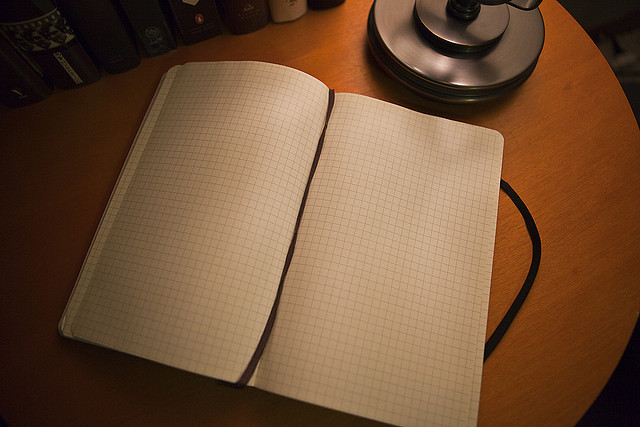With news of a new plugin or new software feature every other week, it is easy to get lost in a myriad of technological ‘solutions’. It is easy to get lost in the “What plugins can I use?” thought. It is easy to forget that sound design is more about communication.
It might be interesting and rewarding to take a step back from the computer to pause………………..and……think.
What is the scene (or gameplay situation) about? What is it trying to communicate? Is anything else (acting, animation, music, voice over, dialogue) already communicating this? Can you support it, supplement it or add another dimension to it? What value is the sound adding to the scene?
It might be more rewarding to take another step back and grab a piece of paper – before you let yourself loose on your sound library. Write down ideas! Don’t be judgemental yet! Allow your mind to create. Allow yourself to be creative without boundaries.
Recently, I have started solving design problems by associating words with the ‘problem’. I find myself usually using cliches and then making them more sophisticated/different as I progress. For example, if I need to come up with a sound for a ‘lightning spell’, I ask myself these questions to begin with:
- Does it do good or evil? EVIL
- What sounds can be evil/frightening/powerful (its lightning afterall!)? Use of low frequencies, animal/monster growls, groaning metal, piercing higher frequency sounds, wood creaks.
- What is the ‘life-plot’ of the sound? (It must begin and end somewhere): If it is lightening, it must crack and then resonate. Quick attack, some sustain, longer release. Most of the power must be communicated in the attack/decay. Must the lightning be literal or can I create something that can be strongly associated with lightning?
Once I have a prototype, I ask myself:
- Does this sound communicate my intentions? (This is usually the best time to get feedback from someone else).
- Is there anything else I can do to make my intentions more clear?
- Must I rework my ideas? Must I think fresh? Do I need more information from the director/designer/supervisor?
I might end up using all of those ideas or none. But, what it forces me to do is to think about the intent of the sound before the process of design. Once I have ideas, I can move on to thinking about the plugins/editing techniques/microphones/tools that help me realise these ideas.
Maybe writing down ideas or associating words might not work for you, but it will be worth the effort to pause………………..and…….think, even if it is for a few minutes, before beginning on a (intimidating!) canvas of nothingness.
Thoughts?


Good stuff!
I think a drawback with the modern DAW technology is actually that it’s so easy and fast to try and build a soundscape.
In the old days it was so cumbersome to actually build it up the sounds so it was wise to spend the time thinking and listening and deciding on what to do and how to combine the elements BEFORE actually doing it.
Quality vs quantity often wins, but today it’s easier to just go for quantity unfortunately.
Sorry:
Quality vs quantity, quality often wins, but today it’s easier to just go for quantity unfortunately.
Great article! Its important to train and expanded our minds so we can analyze a named sound, and really be creative in our approach.
Although what you say may sound a bit obvious, it is actually the key for making good sounds. Planning is essential and very often I haven’t been particularly careful in planning and thinking what I really wanted to achieve. The times I did I had the best results.
Hi, Varun!
I find that an indispensable tool is random listening. Armed with some notion of what the script or the moment calls for, start listening randomly to sounds in your library. Don’t think literally about the sound you are trying to produce or the sounds you are randomly hearing… just try to be aware of the emotional content of what you are hearing. Skip all over the library, paying no attention to whether the categories you are dropping into have anything to do with the story situation you’re working on. When I do this, and I do it often, I almost always make some potentially great discoveries within fifteen minutes or so of listening. I might wind up twisting pieces those sounds to fit the situation, or mimicking certain aspects of them. The important thing that’s happening in this approach is that you are using chance and the complexity of the real world… as opposed to the relative non-complexity of your conscious thoughts about sound… to discover deeper timbral connections, rhythmic connections, and/or thematic connections than you would have come up with by simply brainstorming.
Best,
Randy
hi Varun- a very interesting piece which offers all sorts of things to think about…. for me, I love using literature for clues on how to get to the essence of a design task- since writers arent at all constrained to physical realities- they can freely use simile and metaphor to describe action and locale- I think its great fun to explore those in a sonic exploration to see what might actually “speak” the required sonic character a project demands. As well, active listening in a random manner allows you to hear those sort of aural similes and metaphors when you are in the real world o give you either influences or even actual source material for your design task.
Hi Varun,
Interesting write-up that touches on some thought-provoking ways of approaching sound before actually starting to physically work on the sound that needs to be created. I wrote a piece a little while back about how to overcome sound designer’s writer’s block that touches on a few of the ideas you have outlined here http://gamesounddesign.com/How-To-Overcome-Sound-Design-Writers-Block.html … one of the points is what Randy suggests – to just randomly listen to sounds in your library. I also highly recommend focusing your attention on something completely non-sound related that will kickstart your creative juices… like going to an art exhibit or reading an interesting blog.
Yes, this is something most of us sound people hardly practice, but in reality do we get the luxury of time to sit back and analyze the effect of each sound that goes into the medium we are working in? I am a sound guy in the games industry, and about 80% of the developers I have worked with would want you to deliver 10 okay sounds rather than a couple of great ones in a given time frame. I hope this attitude changes for the better good of the games :). Great article Varun.
Randy in any sound library there will likely be some type of order won’t this affect any randomness in what you are auditioning?
I’ve read about you random auditioning concept before (I think so anyway) and find it interesting, but not always a very effective way to get creative results. But for me it’s a great way to get out of “writers block”.
Great thoughts everyone! Thanks for sharing!
Randy: That is great advice! I think one of the reasons for using a paper+pen was to disconnect myself from my sound library. A lot of times I would find myself already thinking about the design of a sound in the context of my sound library (*that* tire squeal and *that* tiger growl to make *that* sound in my head). The physical disconnection from the computer was probably an attempt think beyond the available options/options I’m used to. Of course, with a library of a large post facility you are bound to come across unfamiliar material that sparks new thought processes :)
Charles: Great advice again! You are right. I’m definitely guilty of underestimating literature/scripts/notes in the past!
Geroge: That’s a great article and thanks for pointing it out!
Eric: Agreed, we *rarely* have the comfort of extra time. Taking a break to think about the work you are doing doesn’t require a lot of time (in most cases, in my opinion) and perhaps it might be worth investing those ten extra minutes. Regardless of the client’s reaction, the work still reflects our capabilities and experiences. Even if the client doesn’t notice it maybe the players/reviewers would. Or maybe one of those players might be a future client? Perhaps it is an ideal way of looking at things, but its good to start somewhere!